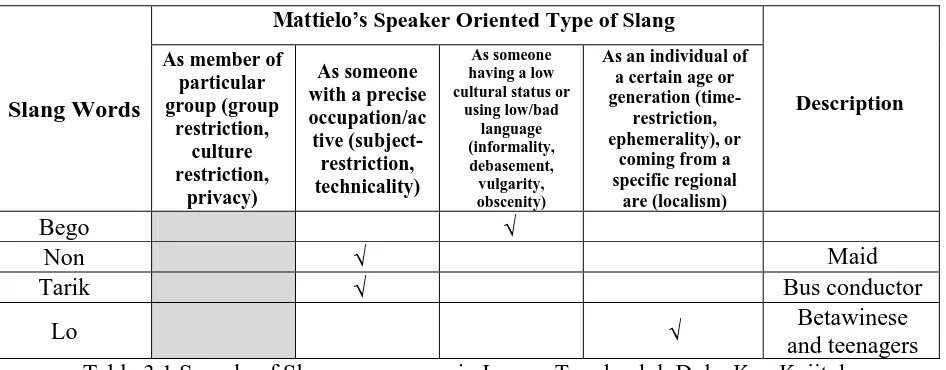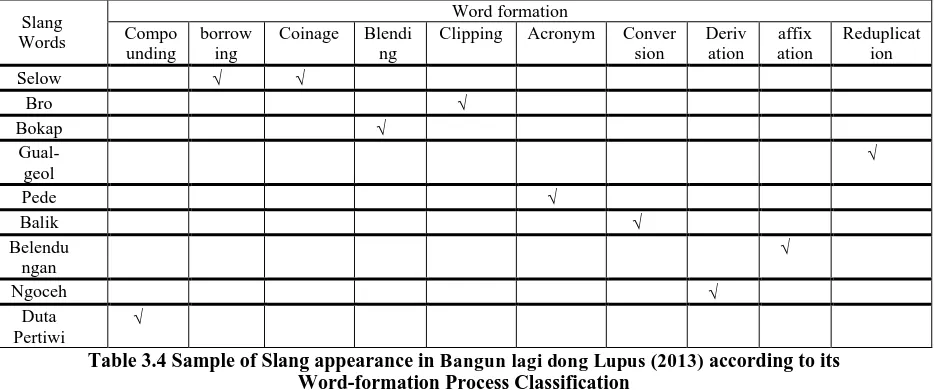CHAPTER III
RESEARCH METHODOLOGY
This chapter describes the research methodology. It contains research design,
data collection, data analysis and sample of data.
A. Research Design
This study uses a descriptive qualitative method since the data are presented in
the form of words. It seeks to identify, describe, and analyze the data in terms of
excerpts of dialogs in the two movies. The qualitative method is considered as the
relevant method since it is concerned with the textual analysis and production
(Flick, 2009). Moreover, this study is qualitative, for it seeks to identify and
analyze the data within their contexts. It examines the slang used in high school
movie with different periods of time.
B. Data Collection
The data of the study were taken from two Indonesian novel adaptation
movies, Lupus: Tangkaplah Daku Kau Kujitak (1987) and Bangun Lagi Dong
Lupus (2013). Lupus is a fiction character of Hilman Hariwijaya’s novel. The novel was first released in 1986 entitled Lupus I: Tangkaplah Daku Kau Kujitak.
Hilman Hariwijaya has released 29 serials of Lupus novel, and the last novel is
released in 2013, entitled Bangun Lagi Dong Lupus. The novel has been adapted
into movies, and TV series. There were six movie titles released since 1987 and 4
seasons of Lupus TV series. Lupus is also popular with their creation of words and
In this research, Sudaryanto’s (1993, p. 133 – 136) methods of collecting data were used.
a. Listening (simak) method can be done through an observation
b. Speaking (cakap) method can be done through a conversation
From those two methods, what is relevant in this research is the first one, the
simak method, as the method of this study.
In this study, in order to collect the data, the movies were watched several
times and the slang said by the actors was written down. Then, the selected slang
was isolated to be the data collection.Data Analysis
The selected data were classified into Mattielo’s (2008) types of slang, and its word-formation process was analyzed according to word formation theories from O’Grady and Guzman (1996), and complemented by Hatch and Brown’s (1995).
1. Sample of Data Analysis
a. Type of Slang
1) Speaker Oriented Type of Slang
Speaker oriented type of slang according to Mattielo (2008) is divided into
four types; Group Restriction, occupation restriction, someone using bad
language, and age or localism restriction. The sample of classification is presented
in table 3.1. Four words, namely bego, non, tarik and lo, are chosen to be the
sample of this speaker oriented type of slang classification from Lupus:
Slang Words
Mattielo’s Speaker Oriented Type of Slang
Description
As an individual of a certain age or Table 3.1 Sample of Slang appearance in Lupus: Tangkaplah Daku Kau Kujitak
(1987) according to Mattielo's Speaker Oriented Type of Slang Classification
As shown in the table, there is no slang in the group restriction type.
Moreover, two words belong to the occupation or activity restriction type, Non ‘Ma’am’ and Tarik ‘pull’. Non is a designation for young woman and usually used by a maid or lower status people, and Tarik is a term used by a bus conductor to
give a signal of departure to the bus driver.
Meanwhile, the other slang belongs to bad language group and age and
localism restriction type. The word bego ‘idiot’ is one of swear words in Bahasa Indonesia and Lo ‘you’ is the pronoun of Betawinese people and for Bahasa Indonesia speakers, Lo is the slang language which is usually used by teenagers in
informal situation.
2) Hearer Oriented Type of Slang
The following table is a sample of the classified data according to Mattielo’s (2008) hearer oriented type of slang. They are playfulness or humor type, novelty
and unconventionality type, desire to impress type, and aggressive or offensive
type. Four words, namely mewek, duta pertiwi, nyolot, bro are chosen to be the
sample of the hearer oriented type of slang from Bangun lagi dong Lupus! (2013)
Slang Words
Hearer Oriented Type of Slang
To amuse the hearer or to make
him laugh (playfulness,
humour)
To release him from the monotomy of
Table 3.2 Sample of Slang appearance in Bangun lagi dong Lupus (2013) according to Mattielo's Hearer Oriented Type of Slang Classification
As shown in table 3.2, mewek ‘cry’ belongs to humor type. It is taken from Lupus’ utterance at 00: 02: 08. The hearer is Lupus’ sister, Lulu. The context of situation where the slang emerges is at Lupus’ house, and Lupus teases his sister who is crying after he lectured her for her prank.
Lulu : “Kak, maafin Lulu kak,”
“I’m sorry,”
Lupus : “Jangan minta maaf sama kakak, minta maaf sama Mami,”
“Don’t say sorry to me, say that to Mom,”
Lulu : “Mam, maafin Lulu, Mam,” (crying)
“Mom, please forgive me, Mom,”
Lupus : “Yaaaaa mewekyaaa, hahahaha”
“Awww a baby’s crying, hahahaha,”
The expression of Lupus when he sees his sister crying, he tries to make her sister
Moreover, Bro belongs to desire to impress type. Bro is the short form of after seeing his girlfriend, Poppy walk with Lupus. According to the situation, bro
belongs to impress the hearer type of slang, where Lupus tries to make an
impression that he wants to act friendly, and he does not want to make trouble.
After classifying the data to its type, frequency analysis was conducted to
determine the differences and commonalities of slang in both movies.
b) Word-formation Process
The following tables are the sample of the classified data of word-formation process according to O’Grady and Guzman (1996), and complemented by Hatch and Brown (1995). Ten word formation processes are chosen; compounding,
borrowing, coinage blending, clipping, acronym, conversion, derivation,
mergokin
nyebur
Anak bangor
In the first movie, nine out of ten word-formation processes are found. From 71
slang words, no word is formed through blending process. One of the examples of
the word formation process is kece. Kece is derived from multiple processes of
borrowing and coinage. It derives from an English Word, ‘catchy’ and it is adjusted to sound more Indonesian. Then kece become a new term.
Slang
Clipping Acronym Conver sion
Table 3.4 Sample of Slang appearance in Bangun lagi dong Lupus (2013) according to its Word-formation Process Classification
Meanwhile in Lupus 2013 movie, all of 10 word formation processes formed
the 91 slang words in the movie. One of the examples of the word formation
processes is balik ‘back side’ is conversion. Balik here means pulang ‘going home’. It becomes a verb which is derived from noun.
After classifying the data to its word formation process, frequency analysis to
be discussed was conducted to determine the differences and commonalities of
slang in both movies.
2. Data Percentage
After the data were classified into the type of slang and word formation, the
observed data were normalized to percentage by using formula:
� = × %
N = the percentage of the observed data in a movie
P = the total of the observed data classification in a movie
Q = the total of all the observed data in a movie.
D. Closing Remarks
This chapter has discussed the method of the study. It comprises the research
design, data collection and data analysis. Research design describes the
methodology used in the study, qualitative method. Data collection and data
analysis describe the procedure in collecting and analyzing data. The elaborated

